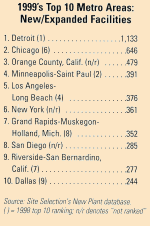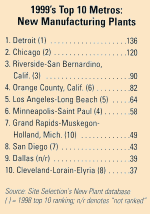“Last one out, turn off the lights.”
A few years ago, that was the rueful joke in Detroit. Even personable Mayor Dennis Archer joshed at a mid-1990s’ blue-ribbon gathering of corporate real estate executives, “I’ve got a lot of empty lots and boarded-over storefronts that I can really get you a good price on.”
But a funny thing happened on the way to the Motor City’s funeral. The lights got brighter. In fact, Detroit pulled off an uncommon hat trick in 1999, repeating for the third straight year as Site Selection’s No. 1 U.S. metro for total new and expanded facilities and for new manufacturing projects.
Above right: Once thought headed for the scrap heap, Detroit is now bringing in new business with neighborhoods like “Trappers Alley” part of the revitalization.
“It’s been at least three decades since we’ve seen a building boom of this magnitude,” says Wayne State University urban planning professor Gary Sands. Indeed, Detroit’s once alarming unemployment rate now hovers near 3 percent.
“The city of big shoulders” also had a strong year, as Chicago moved up to No. 2 from No. 6 in total location projects, and repeated as 1999’s No. 2 metro in new manufacturing.

When it came to overall totals, though, Detroit’s 1999 dominance recalled the “Bad Boy”-era Pistons.
While 1999’s top metros accounted for a jaw-dropping 6,802 new and expanded location projects — some 54 percent of all the U.S. projects Site Selection tallied for 1999 — Detroit alone accounted for 17 percent. Moreover, Motown’s 1999 overall project tally bested No. 2 Chicago’s by a jaw-dropping 75 percent.
The fuel for the Motor City’s renaissance has come from several sources. Veteran observers credit the City Council and particularly Archer (who bagged 83 percent of the vote in his 1997 re-election bid). Other major factors in the Motown rebound have included record-setting sales in the area’s substantial auto sector; markedly improved city-suburban teamwork; an influx of technology-intensive firms and once-lumbering permitting processes that now run at more of a fast-break clip.
Manufacturing: Tighter Margins
For new manufacturing, though, 1999’s margin tightened considerably, with Detroit’s tally besting Chicago by only 12 percent.

1999’s top 10 new manufacturing metros also weren’t as singularly dominant in the larger picture. Nonetheless, their combined 718 projects accounted for some 36 percent of all of 1999’s U.S. new manufacturing total.
California’s bang-up business expansion year also rumbled through the top metro rankings. In fact, four Golden State metros cracked both top 10s: Orange County (No. 3 overall, No. 4 in new manufacturing); Los Angeles-Long Beach (No. 5 in both top 10s); San Diego (No. 8 in both top 10s) and Riverside-San Bernardino (No. 9 overall, No. 3 in new manufacturing).
Three other metros scored ’99 double-doubles by finishing in both top 10s: Minneapolis-St. Paul (No. 4 overall, No. 6 in manufacturing); Grand Rapids-Muskegon-Holland, Mich. (No. 7 in both top 10s); and Dallas (No. 10 overall, No. 9 in manufacturing).
Finally, topped by Detroit’s “threepeat,” most of 1999’s top metros were enjoying extended expansion hot spells. Only three new members penetrated the overall top 10, No. 3 Orange County, No. 6 New York and No. 8 San Diego, and the manufacturing top 10 had but one newcomer, No. 7 Dallas.
